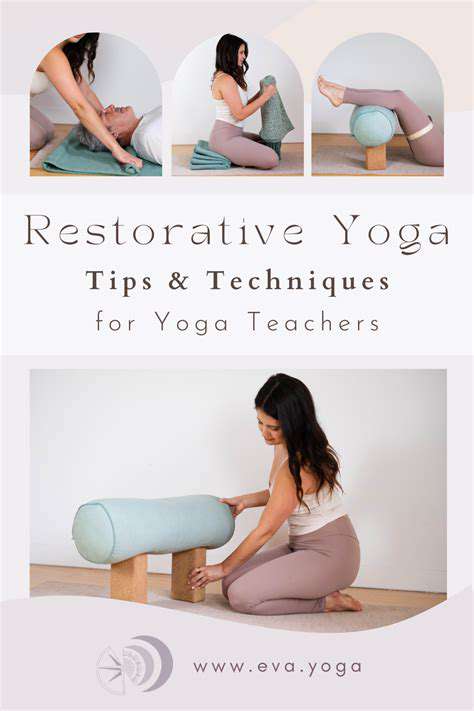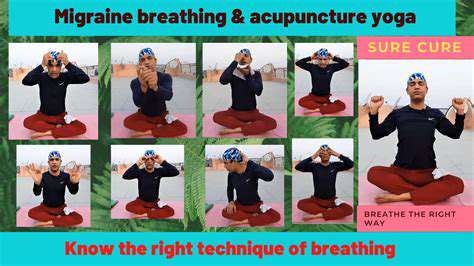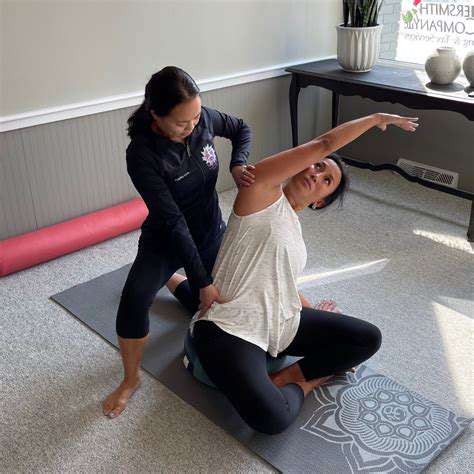
Finding Inner Peace Through Gentle Movement
Imagine sinking into a state of complete tranquility where every muscle unwinds like a coiled spring finally released. Restorative yoga offers precisely this - a sanctuary of stillness where the frantic pace of modern life fades into the background. Unlike more vigorous yoga styles, this practice invites you to linger in supported postures, sometimes for ten minutes or longer, allowing gravity to do the work while you simply breathe.
The magic happens when we stop trying to control everything and instead learn to surrender to the support beneath us. Many migraine sufferers report that this practice helps intercept the tension cycle before it escalates into full-blown pain. The postures are carefully curated to create specific physiological responses - elevating the legs to improve circulation, opening the chest to encourage deeper breathing, or gently stretching the neck to release built-up tension.
Embracing the Power of Supported Postures
Picture being cradled in a nest of soft blankets, your body perfectly positioned to release rather than resist. The strategic use of props transforms ordinary poses into therapeutic experiences. A bolster under the knees during Savasana (corpse pose) relieves lower back tension, while folded blankets under the wrists during supported child's pose prevent shoulder strain.
This meticulous attention to comfort creates an environment where the nervous system can shift from fight-or-flight to rest-and-digest mode. For migraine sufferers, this shift can mean the difference between weathering a storm and being swept away by it. The props aren't just accessories - they're essential tools that make profound relaxation accessible to every body type and ability level.
Cultivating Deep Relaxation and Healing
In our achievement-oriented culture, we often forget that healing requires periods of deep rest. Restorative yoga provides structured downtime where cellular repair and nervous system recalibration can occur. The postures create gentle traction on the spine, improve lymphatic drainage, and encourage diaphragmatic breathing - all factors that may influence migraine frequency and intensity.
Research suggests that regular practice can lower cortisol levels and improve heart rate variability, markers of resilience against stress-related conditions including migraines. It's not uncommon for practitioners to emerge from a session with noticeably reduced headache intensity or even complete relief from migraine symptoms.
The Importance of Breathwork in Restorative Yoga
Breath becomes the anchor in this practice - slow, tidal waves moving through the body with effortless rhythm. Many migraineurs unconsciously develop shallow breathing patterns during episodes, which can exacerbate symptoms. Restorative yoga reintroduces full, nourishing breaths that oxygenate tissues and calm the nervous system.
Specific techniques like extended exhalations trigger the vagus nerve, activating the body's natural relaxation response. This physiological shift can interrupt the pain-spasm-pain cycle common in tension-type headaches and migraines. Over time, these breathing patterns become automatic tools for self-regulation during challenging moments.
Benefits Beyond Physical Relaxation
The ripple effects of this practice extend far beyond the yoga mat. Regular practitioners often report improved sleep quality, better emotional regulation, and enhanced ability to cope with daily stressors - all significant factors in migraine management. The practice cultivates a witnessing awareness that helps separate the experience of pain from suffering about the pain.
Perhaps most profoundly, restorative yoga teaches us that we don't need to earn rest - it's our birthright and an essential component of health. This paradigm shift alone can reduce the stress burden that frequently triggers migraine episodes.
Accessibility and Adaptability of the Practice
One of the most beautiful aspects of restorative yoga is its universal applicability. Whether you're recovering from injury, managing chronic illness, or simply overwhelmed by life's demands, the practice meets you where you are. Skilled instructors can modify every pose to accommodate individual needs - using extra padding for bony areas, adjusting prop heights for comfort, or shortening/lengthening hold times.
This adaptability makes it particularly valuable for migraine sufferers whose abilities may fluctuate day to day. On high-pain days, the practice might involve just two or three simple poses; on better days, a more extensive sequence. The key is listening to the body's wisdom rather than pushing through discomfort.
Active Yoga: Moving Towards Migraine Relief

Active Yoga for Migraine Prevention
When migraines strike, the last thing many sufferers want is movement - yet between episodes, carefully selected active yoga can be preventive medicine. Flowing sequences like gentle sun salutations increase circulation to often-constricted areas (neck, shoulders, jaw) while avoiding the jarring motions that might trigger symptoms. The key lies in maintaining a mindful pace that respects the body's limits.
Emerging research indicates that regular, moderate yoga practice may reduce migraine frequency by up to 40% in some individuals. This likely stems from multiple mechanisms: improved cerebrovascular function, reduced muscular tension, and enhanced stress resilience. The practice also encourages proper postural alignment - critical since forward head posture alone can increase tension headache risk by 60%.
Focusing on Breathwork and Mindfulness
The breath serves as the bridge between movement and meditation in active yoga. Specific techniques like Nadi Shodhana (alternate nostril breathing) have shown particular promise for headache relief, possibly by balancing autonomic nervous system activity. During practice, the breath becomes a diagnostic tool - its ease or restriction revealing areas of hidden tension.
This heightened bodily awareness often allows migraine sufferers to detect and address prodromal symptoms before they escalate. Many report catching jaw clenching or shoulder hiking early enough to prevent full-blown attacks. Over time, this mindfulness extends off the mat, creating space between stimulus and reaction during stressful moments.
Addressing Specific Migraine Triggers
Skilled yoga therapists can design sequences targeting individual trigger patterns. For those with cervicogenic headaches, gentle neck releases and shoulder openers provide relief. Hormonal migraine sufferers might benefit from supported inversions to regulate endocrine function. Even weather-sensitive individuals can learn techniques to stabilize autonomic responses to barometric changes.
The most effective practices often combine precise physical alignment with breath awareness and mental focus - a trifecta that addresses migraines on multiple levels. Importantly, these sequences avoid common triggers like excessive heat, intense backbends, or breath retention that might exacerbate symptoms in sensitive individuals.
Inspect upholstery for wear and damage to assess restoration needs.
Tailoring Your Yoga Practice for Migraine Management
Understanding Migraine Triggers
Migraines can be debilitating, with triggers as unique as fingerprints. Beyond the usual suspects (stress, sleep disruption, dietary factors), subtle triggers often go unnoticed - fluorescent lighting, subtle dehydration, or even postural habits during screen time. Modern tracking apps now make it easier to identify patterns across multiple variables (sleep, weather, activity levels, menstrual cycles).
The most effective tracking looks beyond obvious triggers to uncover hidden contributors. Many discover their trigger is actually a combination of factors - like poor sleep plus skipped meals plus computer work - that individually might be tolerable but collectively spell trouble. This nuanced understanding allows for more targeted prevention strategies.
Restorative Yoga for Migraine Relief
When migraine pain strikes, restorative yoga offers a drug-free path to relief. Supported forward folds gently decompress the cervical spine, while legs-up-the-wall pose improves venous return without straining. The practice's emphasis on parasympathetic activation helps short-circuit the pain cycle, while the structured relaxation prevents the tension that often accompanies pain.
Many sufferers find certain poses provide consistent relief - perhaps a supported bridge pose for sinus-related headaches or a modified child's pose for tension types. The key is maintaining absolute comfort; even slight discomfort can exacerbate symptoms. Darkened rooms, eye pillows, and soothing music often enhance the therapeutic effect during acute episodes.
Active Yoga for Migraine Prevention
Between episodes, a balanced active practice builds resilience. The ideal sequence maintains steady circulation without spikes in blood pressure or intracranial pressure. Flowing movements synchronized with breath keep the body warm and supple, while avoiding the overheating that can trigger some migraines. Emphasis on postural awareness helps correct the forward-head position common in desk workers.
Many practitioners find morning practice most effective for prevention, as it establishes healthy movement patterns before daily stresses accumulate. The practice should leave one energized yet calm - if you're exhausted afterward, you've likely overdone it. This delicate balance is why working with a knowledgeable instructor pays dividends.
Breathwork Techniques in Yoga
Migraine-specific breathwork focuses on techniques that gently regulate nervous system function without creating pressure changes that might aggravate symptoms. Coherent breathing (5-6 breaths per minute) has shown particular promise, as has left-nostril dominant breathing for its calming effects. Even simple extended exhalations can activate the vagus nerve's anti-inflammatory pathways.
During prodromal phases, specific breathing patterns may help avert full attacks - like cooling sheetali breath for heat-related migraines or humming bee breath for stress-triggered episodes. The portability of these techniques makes them invaluable - usable at work, during travel, or in the middle of the night when medications might be inaccessible.
Posture and Alignment in Migraine Management
The modern epidemic of tech neck contributes significantly to headache disorders. Yoga's postural education helps reverse these patterns by strengthening often-neglected postural muscles while releasing chronically tight ones. Simple awareness cues - like imagining the head floating upward from the spine - can reduce compressive forces on cervical vertebrae by up to 50%.
Many migraine sufferers discover their headaches actually originate from referred pain caused by suboccipital muscle tension - an issue directly addressable through proper alignment. Yoga's whole-body approach also corrects compensatory patterns - like how tight hips can contribute to shoulder tension that ultimately affects the neck.
Specific Yoga Poses for Migraine Relief
Certain poses earn regular spots in migraine management sequences. Supported forward bends with the forehead resting on a block gently stretch the neck extensors. Supine twists with a bolster between the knees relieve spinal tension while avoiding excessive pressure. Even simple practices like mindful shoulder rolls at a desk can interrupt tension accumulation.
The most effective poses share common traits: they're symmetrical to avoid muscular imbalance, supported to prevent strain, and easily modified for comfort. Interestingly, the same pose might help one sufferer but trigger another - underscoring the need for personalized guidance. A skilled instructor can help identify which variations work best for your specific migraine patterns.
Lifestyle Considerations for Migraine Management
Yoga's sister science, Ayurveda, offers additional lifestyle wisdom for migraine management. Simple practices like oil massage (abhyanga) before showering may help regulate nervous system function. Consistent meal times support stable blood sugar, while proper hydration maintains cerebrospinal fluid balance. Even the timing of practice matters - many find late afternoon sessions help transition from work stress to evening relaxation.
The most successful approaches weave yoga seamlessly into daily life - perhaps starting the day with three conscious breaths before rising, taking micro-breaks for posture checks, or ending the day with legs-up-the-wall pose. This integration creates multiple touchpoints for prevention throughout the day's natural rhythms.
Combining Yoga with Other Migraine Management Strategies

Yoga for Migraine Prevention
Integrating yoga into a daily routine works best as part of a comprehensive approach. When combined with proper sleep hygiene, targeted supplementation (like magnesium or riboflavin), and trigger avoidance, yoga's benefits multiply. The practice enhances body awareness, making it easier to recognize early warning signs like subtle neck tension or visual disturbances.
Many headache specialists now recommend yoga as first-line therapy for frequent tension-type headaches and as adjunct therapy for migraines. The combination of physical postures, breathwork, and meditation addresses multiple potential trigger pathways simultaneously - something medications rarely achieve.
Mindfulness and Meditation
Meditation cultivates the ability to observe pain sensations without resistance or catastrophic thinking - skills invaluable during migraine attacks. Mindfulness-Based Stress Reduction (MBSR) programs specifically adapted for headache patients show particular promise. These practices appear to thicken the brain's pain modulation centers while reducing activity in pain perception areas.
Fascinating research suggests regular meditators may experience pain differently - not necessarily with less intensity, but with reduced emotional suffering about the pain. This distinction proves crucial for migraine management, where fear of the next attack often compounds the condition's burden.
Dietary Considerations
Yoga's emphasis on mindful eating naturally supports migraine dietary management. The practice enhances interoception - the ability to perceive internal signals - helping identify subtle food sensitivities before they trigger symptoms. Many practitioners naturally gravitate toward regular, balanced meals after establishing a yoga routine, avoiding the blood sugar swings that provoke headaches.
Ayurvedic dietary principles often complement Western migraine diets, both emphasizing warm, easily digested foods while avoiding extremes (very cold, very spicy, or processed foods). The synergy between these approaches creates a robust nutritional foundation for prevention.
Identifying Triggers
Yoga's self-reflection component enhances trigger identification. The heightened awareness cultivated on the mat transfers to daily life, helping spot patterns like breath-holding during stress or jaw clenching while concentrating. Many sufferers discover their triggers are actually maladaptive responses to normal stimuli - a realization that shifts management from avoidance to resilience-building.
Advanced practitioners often detect premonitory symptoms days before attacks - yawning, food cravings, or mood changes - allowing early intervention. This predictive awareness transforms migraine management from reactive to proactive.
Stress Management Techniques
Yoga offers a toolkit for stress modulation at every level - physical (through asana), energetic (through breathwork), mental (through meditation), and emotional (through mindfulness). This multi-layered approach proves more effective than single-technique interventions for the complex stress-migraine relationship.
Studies show yoga practitioners recover from stressors more quickly - a critical advantage since delayed stress recovery is a known migraine risk factor. The practices also appear to buffer against stress sensitization - the process whereby repeated stress lowers migraine thresholds over time.
Acupuncture and other Complementary Therapies
When combined with therapies like acupuncture, yoga's benefits appear to multiply. Acupuncture may enhance yoga's effects by addressing energetic blockages, while yoga maintains the benefits between acupuncture sessions. Similarly, massage and yoga form a powerful duo - massage releases existing tension while yoga prevents its recurrence through improved postural awareness.
This integrative approach aligns with current understanding of migraines as whole-person conditions requiring multi-system solutions. The combination often reduces reliance on medications while improving overall quality of life - a win-win for chronic sufferers.